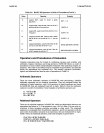
Language Elements
2-12
Logical Operators
The logical operators NOT, AND, OR, XOR, IMP, and EQV are operators that
compare the nth bit
of
argument X with the nth bit
of
argument
Y.
They are
evaluated after the arithmetic and relational operators; therefore, arithmetic expres-
sions resolve to a number which
is
compared with another number. A relational
operator test can be used with logical operations.
If
there are two logical operators
of
the same precedence in a single expression, they are evaluated left to right. Table
2-6
lists the logical operators in order of precedence'. Some examples
of
the logical
operators, used in complex expressions, are shown below.
IF
A>=3.5X
OR
X > 3 THEN
01=0
IF
B=1
OR B=2 OR B=3 THEN
2750
ELSE
280u
IF
(A-B) AND
(B+3)
THEN STOP ELSE
IF
(A AND
B)
THEN CLOSE 2
String Operator
The relational operators may be used with strings to compare them according to
ASCII order.
If
strings
of
unequal length are compared, and the shorter
is
identical
to the first
part
of
the longer, then the longer
is
greater. There
is
one operator only
used with strings: the concatenation operator
(+).
This operator defines a string
as
two
or
more strings joined together.
A$ =
B$+C$
Expressions
Except for the command and stateqlent instructions, all of the language elements
previously discussed can be combined to form expressions. Depending on the type of
constants, variables, and operators used, expressions can be classed as numeric or
string.
Numeric Expressions
In BASIC-80, numeric expressions are created with numeric variables, constants,
functions, and operators. Variables are initialized with
0, and may be assigned other
values with assignment statements, or with
INPUT statements during program
execution.
Any function which returns a numeric value can be used in a numeric expression.
Strings can only be used if they are converted to a number. Numeric expressions can
use arithmetic, logical,
or
relational operators. Some numeric expressions:
K(I) = B*SOR(X)
IF
A>12.1 THEN C = C + 1
IF PEEK (2FFFH) AND
OCH
THEN PRINT
"ON"
String Expressions
String expressions can be specified in BASIC-80 using string constants, string
variables, relational operators, and the concatenation operator
(+).
The concatena-
tion operator combines two strings into one.
If
the resulting string
is
longer than
255
characters, execution halts and
an
error message
is
displayed. Some string expres-
sions are:
A$ =
"NAME:"
+
NAME$
IF B1$>R$ THEN 81$ =
""
R$(I)=R$(I) + S$(I) +
"DONE"
BASIC-SO


















